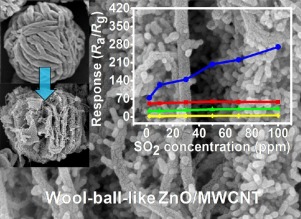Sensors and Actuators B: Chemical ( IF 8.0 ) Pub Date : 2018-01-06 , DOI: 10.1016/j.snb.2018.01.088 Ni Luh Wulan Septiani , Yusuf Valentino Kaneti , Brian Yuliarto , Nugraha , Hermawan Kresno Dipojono , Toshiaki Takei , Jungmok You , Yusuke Yamauchi

|
This work reports a facile glycerol-assisted solvothermal method for synthesizing hierarchical three-dimensional (3D) wool-ball-like zinc oxide (ZnO) nanostructures and their subsequent modifications with multi-walled carbon nanotubes (MWCNTs) as modifiers for achieving sensitive and selective detection of toxic sulfur dioxide (SO2) gas. Structurally, the as-synthesized 3D wool-ball-like ZnO is assembled of two-dimensional (2D) plate-like structures, which themselves are arranged by numerous small nanoparticles. Furthermore, in this work we observed an interesting new phenomenon in which when a high concentration of MWCNTs is introduced, many small nanorods grew on the surface of the plate-like structures which assemble the 3D wool-ball-like ZnO nanostructures. When evaluated for SO2 detection, the ZnO/MWCNTs (10:1) composite (ZnO:MWCNTs = 10:1) shows a high response of 220.8 to 70 ppm of SO2 gas (approximately three times higher than the response of pure wool-ball-like ZnO) at an optimum operating temperature of 300 °C. Additionally, the composite also displays good stability and selectivity to SO2 with the response to 50 ppm of SO2 being 7–14 times higher than the responses to other tested gases at a similar concentration. The excellent sensing performance of the wool-ball-like ZnO/MWCNTs (10:1) composite is mainly attributed to: (i) the formation of p-n heterojunctions at the ZnO/MWCNTs interfaces, which greatly enhance the resistance changes upon exposure to SO2 gas and (ii) the increased amount of adsorption sites for O2 and SO2 gas molecules owing to the larger surface area of the composite and defects sites generated by the functionalization process of MWCNTs.
中文翻译:

多层氧化锌毛球状纳米结构与多壁碳纳米管的混合纳米结构,用于实现对二氧化硫的灵敏和选择性检测
这项工作报告了一种简便的甘油辅助溶剂热法,用于合成分层的三维(3D)毛球状氧化锌(ZnO)纳米结构及其随后的修饰,以多壁碳纳米管(MWCNT)为修饰剂,以实现敏感和选择性检测有毒的二氧化硫(SO 2)气体。在结构上,合成后的3D羊毛球状ZnO由二维(2D)板状结构组装而成,这些结构本身由许多小的纳米颗粒排列而成。此外,在这项工作中,我们观察到一个有趣的新现象:当引入高浓度的MWCNT时,许多小的纳米棒在组装3D毛球状ZnO纳米结构的板状结构的表面上生长。评估SO 2时检测发现,ZnO / MWCNTs(10:1)复合材料(ZnO:MWCNTs = 10:1)表现出220.8至70 ppm的SO 2气体的高响应(大约是纯羊毛球状ZnO的响应的三倍) )的最佳工作温度为300°C。此外,该复合材料还对SO 2表现出良好的稳定性和选择性,对50 ppm SO 2的响应比对其他浓度相同的测试气体的响应高7-14倍。羊毛球状ZnO / MWCNTs(10:1)复合材料的出色传感性能主要归因于:(i)在ZnO / MWCNTs界面处形成p - n异质结,这大大增强了暴露时的电阻变化到SO 2气体和(ii)由于复合材料的表面积较大以及MWCNTs的官能化过程产生的缺陷部位,导致O 2和SO 2气体分子的吸附部位数量增加。











































 京公网安备 11010802027423号
京公网安备 11010802027423号